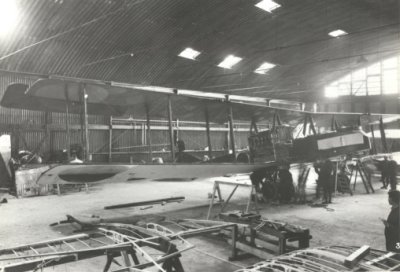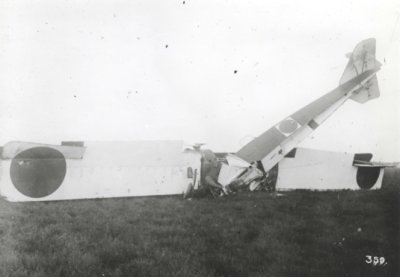History
Gotha G. IV was the successor of the Gotha G. III and conducted various improvements.
Because it was clear that the rear air gunner had difficulties to handle both the upper and lower machine gun, this problem was solved by application of the "Gotha tunnel", connecting both upper and lower gun position in a way that the machine gun could quickly be moved from top to bottom and vice versa.
It was still possible to mount the lower machine gun and also fourth machine gun between the pilot and the machine gun bombardier could be added. In practice, this was rarely used, mainly to save weight.
Other changes were the entirely wooden hull.
In order to improve stability in the transverse direction, ailerons were added to the lower wing
In November 1916 Gotha was commissioned to build 35 aircraft, later increased to fifty. Furthermore, another eighty aircraft ordered from Siemens Schuckert Werke (SSW) and a further 100 by Luft-Verkehrs-Gesellschaft (LVG). This license built aircraft were heavier and slower than the original, since a variety of hull reinforcements had to be made.
The last production aircraft built by SSW generally had a nose wheel mounted to prevent nose standing of the aircraft. Further also Flettner servo tabs were added, later also used in the Gotha GV. To improve the performance and tail of the machines difficult to cope, LVG fitted the aircraft with a larger V-position of the wings.
The last produced machines of SSW and LVG were equipped with less powerful engines and mainly used as trainers.
| Dimensions: | |||
| Length: | 11,86 m | Wingspan: | 23,7 m |
| Height: | 4,3 m | Wing area: | 89,5 m2 |
| Weights: | |||
| Empty weight: | 2400 kg | Max. start weight: | 3635 kg |
| Performances: | |||
| Max. speed: | 140 km/hr | Climbing speed: | 28 min to 3000 m |
| Cruising speed: | - km/hr | ||
| Range: | 490 km | Service ceiling: | 6500 m |
| Miscellaneous: | |||
| Engine type: | Three men | ||
| Crew: | Two 260 hp Mercedes D-IVa engines. | ||
| Armament: | 500 kg Bombs; Two movable 7,9 mm Parabellum MG 14 machine-guns. | ||
August 18, 1917 two German Bombers of the type Gotha G-IV, registered 1055/16 and 1059/16 were on their way back to their home base in Germany. Because of a miscalculation of the navigator they were approaching the Dutch coast. The pilots decided to follow the coast in an attempt to fly to Germany and respecting the Dutch neutral air space. Near the Dollard, they started flying inland. Possibly because of another miscalculation of the navigator and also because of lack of fuel they were flying over the Dutch territory.
The Dutch army started firing on the aircraft and one of the propellers of 1055/16 is hit, causing it to break into pieces. The machine made an emergency landing near Beerta and the crew was interned almost immediately. The other aircraft made also an emergency landing because of lack of fuel, but the crew managed to set fire to the aircraft.
The 1055/16 was dismantled and transported to air base Soesterberg. The aircraft was repaired and the fuselage is painted over with a green colour. The wings were left in their original colours. Dutch roundels and the Dutch serial LA50 were applied.
October 18, 1917 the machine was finished and ready for a test flight. The Dutch crew Van Abeelen, Banning and Van Heyst didn't ever fly in such a large aircraft and they damaged the aircraft. The Gotha was repaired again and used till 1921.

[Enclosed photo from BeeldBank NIMH. Click on photo for ordering information]

Elt.vl. F.A. van Heijst, elt.vl. W.P. van den Abeelen, sgt.ll.vl. G.H. Bannink.
[Enclosed photo from BeeldBank NIMH. Click on photo for ordering information]
| Serial | Second Serial | (German) Werknr. | Bestellnr. | Date in service | Date out of service | Notes |
|---|---|---|---|---|---|---|
| LA50 | G700 | 1055/16 | 18-08-1917 | 1921 | Withdrawn from use. |
Scale 1/72
- Rareplanes
- Kit 3006: an older vacuform kit.
- Roden
- Kit 011: injection moulded kit
Modelling add-on
- ExtraTech
- 72133: detailleringsset t.b.v. Roden kit.
- Part Etchings
- S72-172: Detailleringsset Gotha GIV (Roden)
Decals
- --
- Set --: ---.
Scale 1/48
- --
- Kit --: --
Modeling add-on
Modelling add-on
- --
- --: --
Decals
- --
- Set --: --
| Scheme | Colour name | FS-number | BS-number | Humbrol | XtraColor | Vallejo Model Color | Vallejo Model Air | |
|---|---|---|---|---|---|---|---|---|
| Standard #1 | Upper sides: large hexagons in several colours | zwart | 33 | 70.950 | ||||
| Dark green | 30 | 70.895 | ||||||
| Grey blue | ||||||||
| Grey magenta | ||||||||
| Sides fuselage | Dark green | 30 | 70.895 | |||||
| Other parts | Light blue | X243 | ||||||
Literature.
| Van Brik tot Starfighter | H. Hooftman | 1965 | La Rivière en Voorhoeve - Zwolle | |
| Profile Publications number 115 The Gotha GI - GV | Grosz, Peter M. | Pag. | 1966 | Uitgever: Profile Publications Ltd., Leatherhead, Surrey |
| De Modelbouwer: Werk van leden: een model van de Gotha IV | J.H. Bosman | pag 450 + 451 | September 1987 | Uitg. Ned. Vereniging van Modelbouwers |
| KLu Vliegtuigen: De vliegtuigen van de Koninklijke Luchtmacht vanaf 1913 | Wim Schoenmaker & Thijs Postma | Pag. 15 | 1987 | Uitgeverij De Alk, Alkmaar |
| Aircraft Archive Aircraft of World War One; Volume 2. | Pag. 80 - 87 | 1989 | Uitgever: Argus Books, Hempsted | |
| Vintage Aviation fotofax German Bombers of World War One | Imrie, Alex | Pag. 38 - 40 | 1990 | Uitgever: Arms and Armour Press, Poole, Dorset |
| Camouflage en Kentekens | J.Greuter e.a. | 1997 | Bonneville – Bergen (NH) | |
| Air Enthusiast no.80 The Historical Aviation Journal: Unexpected Windfalls | Bart van der Klaauw | Pag. 54 - 59 | 1999 | Uitgever: Key Publishing, Stamford |
Websites.
- Wikipedia UK: Gotha G-series
- Luftfahrtgeschichte.com: Gotha G.IV
- Constabel.ca: Gotha G.IV
- Gotha G.IV
- Aviastar.org; Gotha G.IV
Thanks to mr F. Gerdessen for providing me with information about the Dutch Gothas.
 Nederlands (nl-NL)
Nederlands (nl-NL)  English (United Kingdom)
English (United Kingdom)